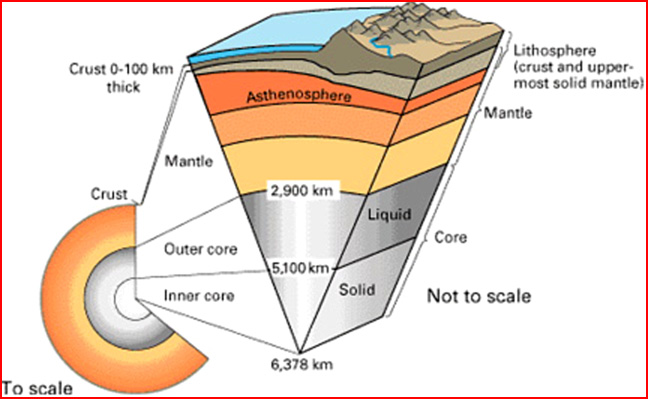|
|
||
 Credit: USGS |
||
|
pic of the day Links:
Society for
|
Oct
27, 2004 Because the Earth is a small charged body moving in a large cell of plasma, explanations of all physical phenomena in, on, and near the Earth must take the electrical behavior of plasma into account. Traditional geology has over many years gradually built up a picture of the Earth's interior. Geologists assumed that gravity pulled upper layers of rock onto lower layers, uniformly increasing the pressure toward the center. Laboratory experiments provided some indications of how rocks responded to increasing pressure and temperature, and theoretical extrapolations from these values provided a basis for guessing what could be going on far beneath the deepest drill holes. The result is the diagram above. A thin crust of light rock floats on the denser material of the mantle, which in turn surrounds an even denser core. At critical values of pressure, temperature, and/or composition, the material may change states, from solid to plastic at the asthenosphere, from solid to liquid at the outer core. Extrapolations of seismic wave behavior and deductions from theory (with appropriate adjustments) justify an interpretation of earthquake waves that confirms the expectations of pressure and temperature theories. The anomalies can probably be explained if enough funding is allocated to study them. But becoming aware of plasma changes everything. Because gravity can distort atoms and because pressure can preferentially "squeeze" electrons out of lower layers, rock can become susceptible to electromagnetic forces. Because plasma cables and sheets (i.e., electrical currents) have been detected flowing between Earth's magnetosphere and the surface, the circuit must close by passing through the Earth. Because magma is a liquid plasma, it will preferentially carry currents. Because electrical currents in plasma pinch into filaments and tend to form "double layers" (capacitor-like formations), the distribution of currents inside the Earth will be highly inhomogeneous. Electrical heating will cause temperature discontinuities in "lines and lumps." Electromagnetic forces between current filaments and between the layers of double layers will cause enormous and sudden pressure variations. Why doesn't this show up in seismographs of earthquakes? Or does it show up, then go unrecognized because researchers have no concept of plasma behavior? No one has ever investigated how seismic waves act in different plasma conditions. The seismograph scrawls a single wavy line, but the geologist must interpret it according to a choice among several competing theories. With the awareness of plasma, seismographs no longer provide reliable--or even understandable--information about conditions at depth. Plasma geology is a virgin field for curious and enterprising investigators. In this age of scientific conformity and consensus truth, are there any geologists left who have a sense of adventure?
|
|
|
Copyright 2004: thunderbolts.info |
||
